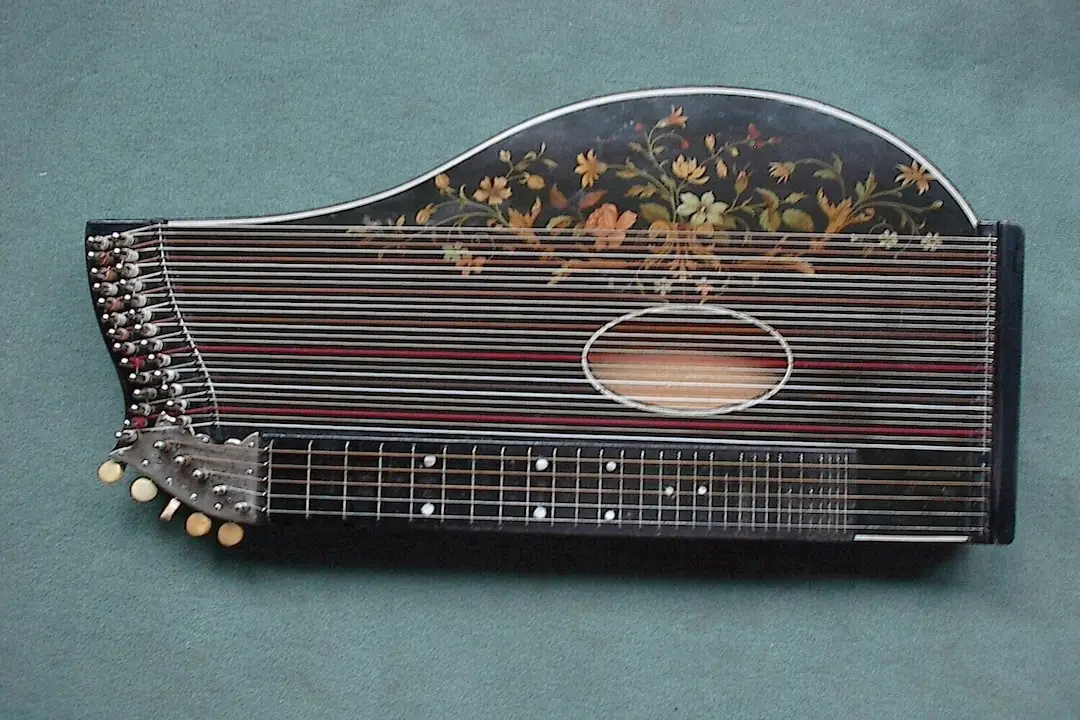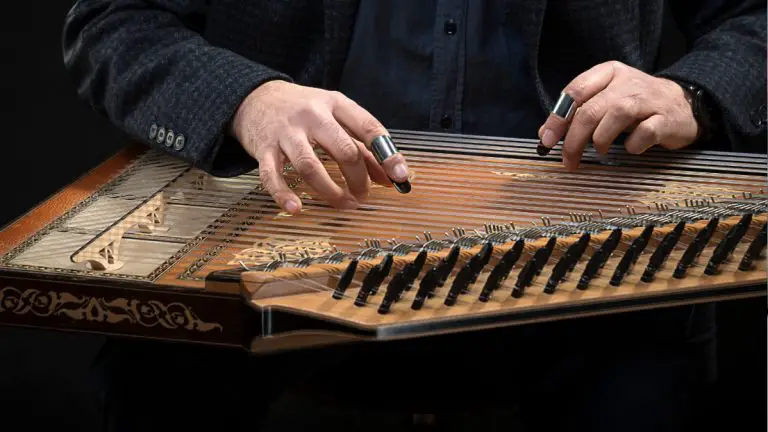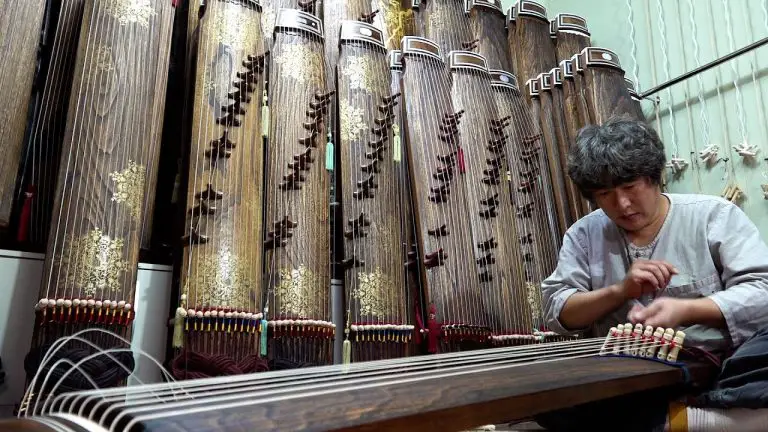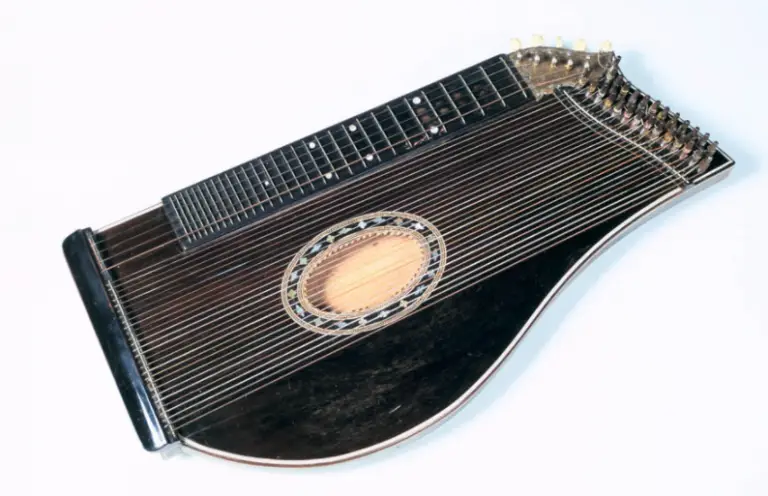What is the History of the Zither: Tracing the Strings Through Time
Folkstrings.com is reader-supported. When you buy through links on our site, we may earn a small commission.
The zither is a family of stringed instruments that has a rich and varied history, tracing its roots back thousands of years. As a musical tool, its origins can be found in multiple cultures and regions, evolving over the centuries into a range of styles and forms.
The zither’s gentle tones are produced by strumming or plucking the strings, resonating through its flat body.
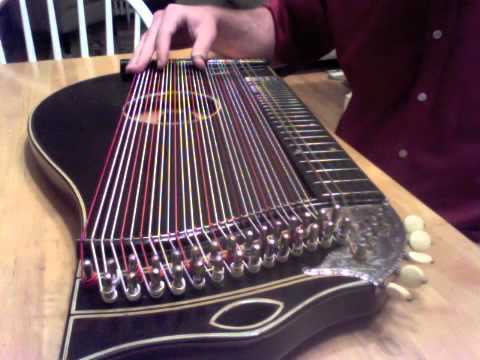
Instruments akin to the zither have been depicted in ancient Chinese texts and artifacts, signifying its historical significance and deep cultural roots. The Chinese guzheng, for example, boasts a history of over 2,500 years and continues to captivate with its elaborate melodies and intricate design.
Over time, the zither spread geographically, adapting to local musical traditions and giving birth to various adaptations such as the European zither, with its distinct structure and playing techniques.
Key Points
- The zither encompasses a variety of stringed instruments with ancient origins.
- Design variations of the zither reflect its geographical spread and cultural integration.
- Modern adaptations of the zither maintain its cultural legacy while introducing contemporary elements.
Table of Contents
Origins and Historical Development
When I explore the zither’s past, I’m delving into a story rich with cultural exchanges and musical ingenuity.
Ancient Roots and Greek Influence
The zither’s lineage can be traced to ancient times. One of its forebears is the cithara, an instrument with strong connections to Ancient Greek culture. This term “cithara” stems from the Greek word kithara, which referred to a large, wooden lyre.
These instruments were central to Greek music and suggest an early appreciation for the distinctive sound that would evolve into the zither we know today.
Medieval Transformations
During the medieval era, the zither underwent significant transformations. It morphed from its Greek predecessor into various shapes and sizes throughout Europe.
Notably, the term “zither” began to be used more widely, encompassing a range of musical instruments with similar characteristics—a flat body with strings stretched over it played by plucking or strumming.
Renaissance Innovations
The Renaissance period was a hotbed of innovation for the zither. Renowned figures like Michael Praetorius documented these musical developments. His works provide detailed insights into the instrument’s evolution with specifications about its design and playing methods.
Renaissance craftsmen brought standardization and refinement to the zither, setting the stage for its modern variants.
Geographical Expansion and Evolution

I’m excited to guide you through the zither’s remarkable journey as the instrument blossomed across various cultures and continents, adapting to local musical traditions and influencing myriad musical styles.
European Adaptations
In Europe, the zither underwent significant transformations, especially in Austria and Germany where it secured a place in local music culture.
I observed how in the Alpine regions, the instrument evolved into what is known as the Alpine zither. Variants like the concert zither feature a fretted fingerboard alongside open strings, and these versions were crafted to facilitate complex melodies and chords.
Zithers in Asia
As the zither’s presence expanded to Asia, particularly in China and Japan, it took on new forms and roles in music.
For instance, the Chinese guzheng and Japanese koto, which are both traditional zither-like instruments, share a parallel history with the European zither.
These instruments have a revered status and are integral to their respective classical and folk music scenes.
Chinese guzheng, for example, dates back to ancient times and consists typically of 21 strings and movable bridges.
Influence in the Americas
In the United States, the zither found a warm reception among diverse immigrant communities and American folk music traditions.
I’ve seen the instrument’s influence in the Appalachian dulcimer, a form of fretted zither, being a staple in American folk music. This demonstrates the zither’s adaptability and its continuous evolution as it intermingles with pre-existing musical styles across the Americas.
Design and Construction

In exploring the zither’s design, I find that materials and craftsmanship create a unique sound profile. This section delves into its physical characteristics and variations in string arrangements, revealing the intricacies behind its construction.
Physical Characteristics
The zither typically has a flat, rectangular sound box which serves as the resonating chamber to amplify the vibrations of the strings.
I’ve observed that the choice of materials plays a crucial role in determining the tonal quality of the instrument.
The sound box is usually made of wood, while the strings were traditionally made of gut but are now often replaced by metal for additional durability and a brighter tone.
The zither’s shape isn’t overly complex, but its simplicity belies the careful engineering required to balance acoustics and playability.
- Shape: Generally flat with variant contours depending on the model.
- Materials: Predominantly wood for the sound box; metal strings.
- Sound Box: Essential for amplification, typically rectangular.
Variations in String Arrangements
I’ve particularly noticed that zithers can greatly differ in their string configurations.
Some zithers, like the trapezoidal zither, have strings that span across the entire length of the instrument with no fretboard, allowing them to be played by plucking or strumming.
Other stringed instruments within the zither family might include variations with added fretboards, enhancing their versatility.
- Strings: Number can vary, influencing the range and sonic possibilities.
- Fretboard: Present in some zithers, absent in others like the trapezoidal zither.
Playing Techniques and Usage
Exploring the zither’s playing techniques and usage unveils a rich tapestry of historical and contemporary styles. These methods range from using artificial nails to enhance the sound to incorporating vibrato for musical expression.
Traditional Playing Methods
My approach to the zither historically involves both delicate and dynamic techniques.
For traditional playing, you’d typically find me using my fingers or a plectrum to pluck the strings.
- Fingers: Traditionally, players like me would use artificial nails made of materials such as stag horn, silver, or jade to pluck the strings. This method allows me to produce a clear, precise sound.
- Plectrum: In some styles, players may also use a plectrum for a brighter tone.
When playing traditionally, I often aim for a balance between melody and accompaniment. Since zithers can be fretless, my left hand might slide along the strings to vary the pitch, creating dynamic and expressive tunes.
Modern Styles and Innovations
As I move into the modern era, my playing style evolves with new techniques and innovations.
- Plucking: I’ve seen variations where open strings are plucked in a contrasting manner to solo playing styles within zither music.
- Bow: While less common, some of us may also use a bow to coax sound from the zither, adding a different texture to the music.
In modern styles, my right hand is often responsible for producing melody, with the left hand sometimes providing accompaniment. However, some innovative players have expanded these roles, experimenting with techniques that push the boundaries of traditional zither music.
Cultural Significance and Legacy
The zither, with its enchanting strings, has played a pivotal role in the soundscape of various cultures. Now, let me take you through its influence on music and film, as well as its enduring presence as a folk instrument.
The Zither in Music and Film
The zither secured a special place in the world of cinema through the 1949 British film The Third Man. Its soundtrack featured the distinctive tones of the zither, played by musician Anton Karas, whose work highlighted the instrument’s unique sound and contributed significantly to the film’s atmosphere.
This association with a classic movie has immortalized the zither, making its sound instantly recognizable to many.
Zither as a Folk Instrument
As a folk instrument, the zither holds a cherished spot across various cultures.
In Scandinavia, the instrument’s sweet melodies are a traditional accompaniment for dances and songs, reflecting the region’s cultural heritage.
Similarly, in Southeast Asia, the zither is integral to the musical lexicon, with variations of the instrument used in several countries, each adopting it into their traditional music practices.
The zither’s role as a folk instrument has been instrumental in preserving and celebrating the musical heritage of these diverse communities.
Modern Zither and Its Variants
In exploring the world of zithers, I find that modern adaptations and variants like the concert and Alpine zithers, autoharps, and hammered dulcimers, reflect a rich diversity within the zither family.
Concert and Alpine Zithers
The concert zither is distinguished by its flat body and multiple strings. Typically, it consists of five fretted melody strings and 29 unfretted accompaniment strings.
I’ve come to appreciate its complexity. It requires both picking and strumming techniques to create its characteristic sound.
The Alpine zither, a close relative, shares a similar structure. However, it often comes in regional forms with variations in the number of strings and tuning. These variations reflect the cultural nuances of the Alpine regions.
- Concert Zither
- Melody strings: 5 fretted
- Accompaniment strings: Usually 29 unfretted
- Alpine Zither
- Variations: Regional tuning differences
- Purpose: Reflects Alpine cultural nuances
Autoharps and Hammered Dulcimers
I’m fascinated by the autoharp, a string instrument which simplifies playing. It uses a series of chord bars to dampen unrelated strings, allowing for full chords to be played easily.
It’s an evolution within the zither family that caters to both beginners and experienced musicians alike.
The hammered dulcimer, on the other hand, is a percussive member of the family. It is played by striking strings with small mallets. This creates a lively and resonate sound, one that can fill a room with its ringing tone.
- Autoharp
- Chord bars: Simplifies playing
- Accessibility: Ideal for various skill levels
- Hammered Dulcimer
- Playing method: Struck with mallets
- Sound: Lively and resonant
Frequently Asked Questions

In this section, I will address some of the most common inquiries about the zither, its history, evolution across cultures, and its modern-day significance.
Who invented the zither and what is its origin story?
The zither’s inception can be traced back several centuries with roots in Asia and Europe. However, pinpointing a single inventor is elusive. Its development is a product of many hands and cultures contributing to its current form.
How did the zither evolve in different cultures around the world?
Cultures across Europe, Asia, and beyond modified the zither according to local musical traditions, leading to a rich tapestry of variants. Each culture’s influence is evident in the unique playing techniques and designs that have emerged.
What are the different variations and types of zithers?
Types of zithers vary widely, from the simple ones with few strings to complex versions such as the concert zither with a fretboard, and the Alpine zither, celebrated in Bavarian music.
In what ways has zither music impacted the art and culture of societies?
Zither music has historically been a facet of folk traditions and classical repertoires. It carved a niche for itself in the cultural expressions of societies and inspired gatherings and dances.
What are some notable periods in history where the zither gained popularity?
The zither gained significant popularity during the 19th and early 20th centuries, especially within the Austro-Hungarian Empire. It also experienced a revival in the American folk music scene in the 1950s.
How is the zither used in contemporary music and arts today?
Today, the zither finds its place in a variety of genres. It can be found in folk to avant-garde. It also continues to enchant with its distinctive sound in soundtracks and experimental music projects.
Author Profile
-
Daniel Johnstone is an English writer with a love for stringed instruments from around the world.
He shares his love for these instruments through his writing for folkstrings.com, a website dedicated to all things related to folk string music.
Daniel's passion for music started at a young age, and he has since become an accomplished musician, playing guitar, cavaco, and recently, the harp.
His dedication to learning and sharing his knowledge of stringed instruments is evident in his insightful and engaging blog posts. Whether you're a seasoned musician or a beginner, Daniel's writing is sure to inspire and entertain you.
When he's not playing music or writing, you can find Daniel exploring new instruments and seeking out new sounds to share with his readers.
Latest entries
 AutoharpApril 4, 2024What Is the Autoharp Made Of: Exploring Its Materials and Craftsmanship
AutoharpApril 4, 2024What Is the Autoharp Made Of: Exploring Its Materials and Craftsmanship AutoharpApril 4, 2024Is Autoharp Easy to Play? Unveiling the Truth for Beginners
AutoharpApril 4, 2024Is Autoharp Easy to Play? Unveiling the Truth for Beginners AutoharpApril 4, 2024What Is an Autoharp Worth? Your Guide to Pricing and Value
AutoharpApril 4, 2024What Is an Autoharp Worth? Your Guide to Pricing and Value AutoharpApril 4, 2024Are Autoharp and Zither the Same Thing? Unraveling String Instrument Myths
AutoharpApril 4, 2024Are Autoharp and Zither the Same Thing? Unraveling String Instrument Myths
Affiliates:
This post may contain affiliate links that at no additional cost to you, the site may earn a small commission. We only recommend products we would use ourselves and all opinions expressed on this site are our own.
Accuracy Advice:
While we strive to provide up-to-date and accurate information, the content in this article may not reflect the most current research or medical guidelines. We encourage readers to do further research and consult with professionals for more personalized advice.
Our Recommendations:
The products and services mentioned in any of our articles are recommended based on our independent research and personal experience. We are not sponsored by any company. We aim to suggest products and services we believe are of high quality and could be beneficial to our readers.

